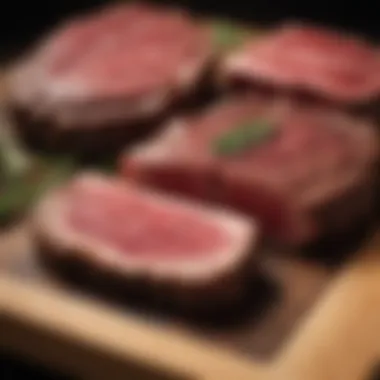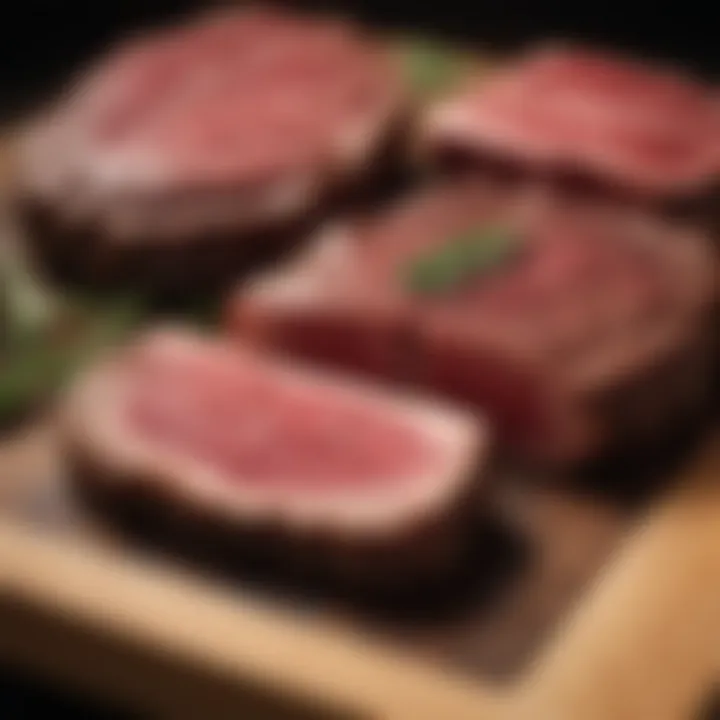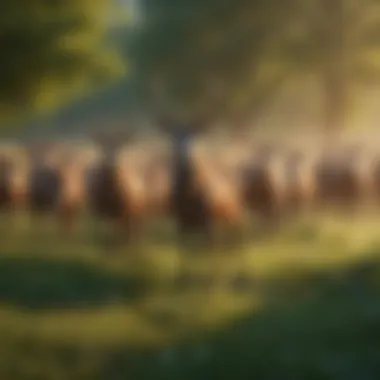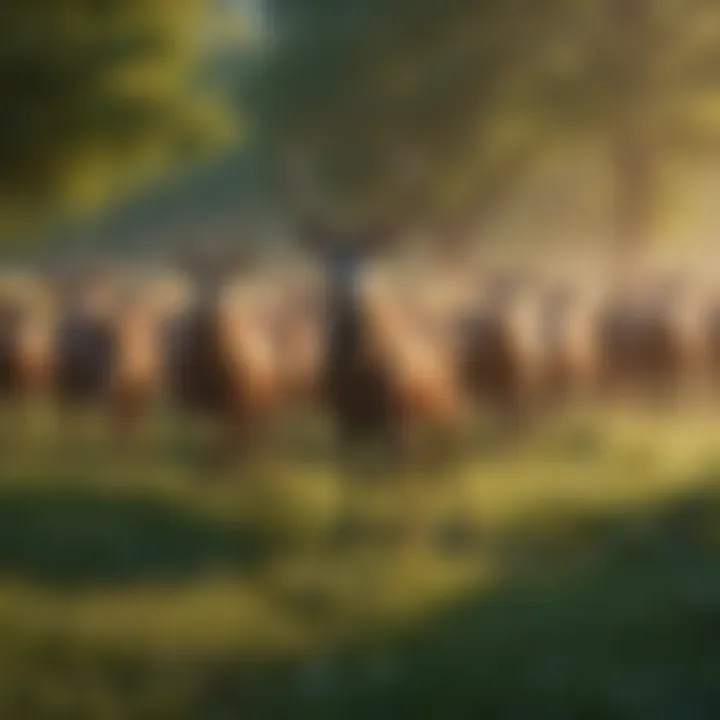Viability of Venison Farming: Sustainable Practices


Intro
In recent years, venison has emerged as a favored alternative to traditional meats like beef and pork due to its low fat content and rich flavor profile. As more people lean toward sustainable and ethical food sources, farming deer for venison becomes an appealing prospect for many within the agricultural landscape. However, the journey into venison farming isn't a walk in the park. It requires thorough understanding of environmental considerations, animal welfare, and market dynamics.
For those thinking about venturing into this niche market, grasping the essential aspects from effective management techniques to ethical concerns is crucial. This article aims to dissect these elements step-by-step, shedding light on the unique features of venison farming while emphasizing sustainability and practical applications.
This exploration serves dual purposes: aiding aspiring farmers in their quest for new opportunities and providing seasoned professionals insights on diversification. With these objectives, one can confidently navigate the complex terrain of venison farming.
Understanding Venison Farming
Venison farming represents a crossroads where sustainable agriculture meets growing consumer demand for ethically sourced meat. With an increasing interest in health and nutrition, people are leaning towards alternatives that align with their values. The importance of understanding venison farming lies in grasping its potential for providing high-quality protein while minimizing the environmental footprint compared to traditional livestock farming. This article will dissect various fundamental aspects, opening the gate to a greater appreciation of this niche market.
Definition and Scope
Venison farming is the cultivation of deer specifically for meat production. Unlike conventional livestock, deer are generally more adaptable and require less land and feed. This not only allows farmers to be more flexible but also presents diverse farming opportunities.
Within the scope of venison farming, some key areas of focus emerge:
- Animal Welfare: It’s crucial to ensure that husbandry practices meet high standards of animal welfare, which can greatly affect meat quality and farm reputation.
- Market Trends: A growing health-conscious consumer base seeks out low-fat, nutrient-rich venison, which presents a golden opportunity for farmers willing to enter this market.
- Sustainability: Venison production can be more sustainable, using fewer resources and leading to less land degradation compared to traditional agriculture.
The boundaries of venison farming extend beyond just the animals. They involve community involvement, ecotourism possibilities, and exploring local markets. Understanding these dynamics is essential for anyone looking to embark on this farming journey.
Historical Overview
Historically, the consumption of venison dates back to ancient tribes who hunted deer for sustenance. With the rise of agricultural practices over the centuries, deer farming emerged as a more structured approach to meat production.
In the late 20th century, particularly in countries like New Zealand and the United States, venison farming began to gain traction as a viable agricultural practice. Farmers found deer to be less demanding in terms of care when comparing with cattle and pigs. The unique properties of venison, such as its lower fat content and high protein, began to attract attention across the globe.
As the health benefits became more recognized, the venison market expanded dramatically. Hunting traditions also influenced developmental trajectories in various cultures, contributing to diverse production styles globally. Today, the potential for venison farming continues to evolve, embedding deeper into agricultural frameworks while responding to shifting consumer preferences.
"Venison, once considered a luxury, is slowly carving its niche in everyday diets as people wake up to its unique benefits."
Exploring venison farming not only involves understanding the business implications but also encompasses historical significance, showcasing its transformation from a sustenance necessity to a commercial agricultural venture.
The journey into venison farming isn’t just about breeding deer; it's about realizing an opportunity that's been centuries in the making.
Types of Deer for Farming
Understanding the various types of deer optimal for farming is pivotal in tapping into the potential of venison production. Each breed carries its own characteristics, which can significantly impact the success and operational ease of a venison farm. Selecting the right type can not only enhance productivity but also play a role in market preference, sustainability, and overall farm management.
Popular Breeds in Venison Farming
When it comes to breeds, certain ones have made a name for themselves in the venison farming landscape. The Red Deer, for instance, is often regarded as a prime choice due to its size and adaptability. Known scientifically as Cervus elaphus, they are large and provide a substantial amount of meat. They also offer a good balance in terms of temperament, making them easier to manage for farmers.
Another commendable breed is the Sika Deer, which is smaller but grows quickly and produces high-quality meat. The Sika Deer, or Cervus nippon, is also noted for its ability to thrive in various environments, allowing farmers some flexibility in location selection.
Lastly, there’s the Fallow Deer, recognized for its distinctive and beautiful antlers. The Dama dama is another favorite among farmers looking to diversify their production. Not only does it yield a mild and delicate flavor in its meat, but it's also relatively easy to handle, making it a strong contender for those new to venison farming.
Ultimately, selecting a breed depends on several considerations:
- Meat quality and market demands
- Farming practices and habitat
- Climate adaptability
- Growth rates and reproduction traits
Adaptability to Various Climates
The adaptability of deer to different climates is a key factor in establishing a sustainable farm. Venison farming isn't confined to one type of environment; several deer breeds can flourish in multiple climatic conditions.
For example, Red Deer are known to withstand colder climates, making them suitable for northern regions. This trait allows them to maintain health and growth even when temperatures dip. Contrastingly, Sika Deer show remarkable resilience in warmer, temperate climates, which opens options for farmers in diverse geographical locations.
Fallow Deer, on the other hand, are quite versatile, as they have been successfully farmed in various regions ranging from temperate to mild climates. They can adapt quite well to changes, which can be a boon for farmers looking to expand their operational territories in the future.
"The choice of deer breed and its adaptability are essential elements that can significantly influence the success of a venison farm."
Establishing a Venison Farm
When thinking about diving into the world of venison farming, one must place particular weight on the foundation of this venture. Establishing a venison farm doesn’t only revolve around purchasing deer; it also encompasses a myriad of essential factors that can influence both productivity and sustainability. In various agricultural discussions, the setup phase is often overlooked. However, it should be the backbone of a successful operation. A well-laid groundwork translates to a more resilient farm, able to weather the storms of market fluctuations and environmental trials.


Location and Land Requirements
Choosing the right location is more than simply picking a piece of land. Geographic location plays a crucial role in the success of your farm. Areas with adequate space, optimal forage, and favorable climate conditions will set the stage for a thriving deer population. Generally, a minimum of 10 to 20 acres is recommended but this can vary based on the number of deer you plan to raise. However, it's not just about how much land you have; you need to consider soil quality, access to water sources, and the availability of natural shelter.
Moreover, proximity to markets can greatly affect your operational costs. Being near urban centers could help cut transportation expenses and widen your customer base, as venison products continue to grow in popularity among health-conscious consumers.
- Access to fresh water: Deer, like other livestock, require a steady supply of fresh water. Make sure your prospective land has access to clean, potable water sources.
- Natural cover and grazing: Areas providing natural vegetation can reduce feeding costs and play a critical role in the deer’s health.
Infrastructure Needs
Once the location checks out, the infrastructure comes into play. Proper facilities are integral to ensuring safety, health, and productivity. You’ll want to invest in fencing, as deer are known for their agility and will make any attempt to escape if possible. A sturdy, tall fence is indispensable for keeping deer secure and enclosed. It’s often suggested to use a high-tensile wire fence which minimizes the risk of injury to the animals.
Additionally, shelter should be constructed to protect deer from harsh weather conditions. This can be as simple as a basic barn or natural cover, but ensure it's clean and spacious enough not to cause overcrowding. In terms of feed, consider setting up a designated area for storage to protect grains from pests.
- Feeding stations: Properly placed feeding stations can optimize the feeding process, making it more efficient and effective.
- Handling facilities: A pen or chute for administering health checks or transporting animals will make your job much easier and safer when it comes to basic husbandry practices.
Legal and Regulatory Considerations
Navigating the legal landscape is often the tricky part for many keen farmers. Each location may have different regulations concerning livestock management which could affect venison farming. It is absolutely critical to familiarize yourself with local, state, and even federal laws that relate to raising deer. Certain permits may be necessary depending on your jurisdiction, especially if you plan to sell venison commercially. This might include health inspections or licenses for selling game meat.
Moreover, sustainable practices are increasingly being required by legislation. Familiarizing yourself with these regulations isn’t just essential for compliance; it provides an opportunity to deepen your commitment to ethical farming.
"Being informed about the rules helps avoid any nasty surprises down the road and can lead to more sustainable practices that might even attract more customers."
Understanding the full scope of legalities can initially seem daunting, but it’s an investment in your farm's future. Taking this time upfront can save you from potential legal hassles that can arise later on.
In summary, establishing a venison farm involves careful consideration of location, infrastructure, and legal requirements. By devoting time and upfront effort into these elements, you are investing in a stable foundation that, in the long run, can lead to a successful and sustainable venison farming enterprise.
Animal Husbandry Practices
Animal husbandry practices are fundamental to creating a successful venison farming operation. These practices encompass a variety of techniques that ensure not only the health and wellbeing of the deer but also the efficiency of the farming process. By emphasizing these practices, farmers can cultivate a productive environment that maximizes yield while promoting ethical treatment of the animals.
Feeding and Nutrition
Feeding and nutrition play a crucial role in deer farming. Proper nutrition directly impacts growth, reproduction, and overall health. Deer are browsers, favoring a diet that includes a mix of forage such as grasses, leaves, and shrubs. Therefore, the formulation of a balanced diet is essential. It’s advisable to include protein-rich supplements, minerals, and vitamins to enhance growth rates and reproductive capabilities.
Some farmers have found success in using specially formulated deer feed, which can ensure that the nutrient needs are met—especially during critical growth periods or harsh weather conditions. It's also important to monitor deer weight regularly to adjust their diet as needed.
Benefits of appropriate feeding strategies include:
- Improved growth rates
- Enhanced reproductive success
- Stronger immune systems
Health Management Strategies
Health management is another pillar of effective venison farming. This element involves routine veterinary care, vaccination programs, and disease prevention strategies. It’s wise to establish a health management plan before beginning the farming venture. Regular check-ups and prompt treatment of illnesses can not only safeguard the health of the animals but significantly reduce long-term costs related to health problems.
Some key strategies might include:
- Vaccination against common diseases such as bluetongue and chronic wasting disease, to mitigate outbreaks
- Regular parasite control to ensure that the deer do not suffer from infestations that impact their health
- Environmental management, which includes keeping the living area clean and minimizing stressors that could lead to illness
"A stitch in time saves nine"—taking proactive measures now can save resources and animal lives later.
Breeding and Reproduction Techniques
The breeding and reproduction of deer on a farm require careful planning and execution to maintain strong genetics and healthy populations. Farmers often engage in selective breeding to enhance desirable traits such as size, temperament, and disease resistance. Understanding the reproductive cycle of deer is essential, as they typically breed in the fall, with fawns born in the spring.
To optimize breeding outcomes:
- Monitor the estrous cycles of does and ensure they are bred at the right time
- Introduce proven bucks to the herd to improve offspring quality
- Provide an environment conducive to mating, which often includes adequate space and social structures
Ethical considerations also come into play, as responsible breeding practices are critical for maintaining animal welfare. Overall, these practices can significantly contribute to a thriving venison farming operation.
Ethical Considerations
Ethical considerations are paramount when discussing the viability of venison farming. These factors encourage responsible practices that not only respect the animals involved but also cater to growing consumer demands for humane food sources. The world is becoming increasingly conscious of how its food is produced, and understanding the ethical frameworks of venison farming is essential for both aspiring farmers and consumers alike.
Sustainable Farming Practices


Implementing sustainable farming practices is a cornerstone of ethical venison farming. This entails balancing economic viability with environmental stewardship. By adopting methods such as rotational grazing, venison farmers can promote soil health and reduce the risk of overgrazing. Grazing deer can naturally aerate the soil, enhancing its nutrient content, which is a smart boon for both the wildlife and the vegetation.
Moreover, sustainable practices can minimize the carbon footprint of the farm. Utilizing resources such as solar panels for energy needs or rainwater harvesting for irrigation helps in cutting down reliance on non-renewable resources. Every farmer should recognize that sustainable practices help ensure long-term viability not just of their business but the ecosystem as a whole.
- Benefits of sustainable farming practices include:
- Improved animal health
- Enhanced biodiversity
- Reduced dependence on chemical inputs
- Increased market preference for sustainably sourced venison
"Farmers who practice sustainability are not just building a business; they are investing in the future of our planet."
Animal Welfare Standards
Animal welfare standards play a pivotal role in ensuring that deer are treated humanely throughout their lifecycle. Welfare issues can range from the living conditions provided on the farms to the methods employed during harvesting. Venison farmers must adhere to strict welfare protocols to avoid cruelty and neglect, which could tarnish the reputation of venison as a food choice.
Practices aimed at ensuring animal welfare often include:
- Providing adequate space for movement and social interaction
- Ensuring appropriate nutrition and regular access to fresh water
- Conducting regular health checks and vaccinations to prevent disease
- Utilizing humane slaughter methods that reduce stress and pain involved in the process
By maintaining high animal welfare standards, venison farmers not only comply with legal regulations but also cultivate consumer trust. Today’s consumers are more discerning, actively seeking products from farms that prioritize ethical treatment of animals. Therefore, investing in animal welfare isn’t just about compliance; it’s about creating a brand that stands for quality and integrity in a crowded marketplace.
Economic Aspects of Venison Farming
Understanding the economic aspects of venison farming is crucial for anyone considering this venture. It provides insights into profitability, market demands, and the sustainability of operations. Venison, as an alternative source of meat, is gaining traction not only for its unique flavor but also for its assumed health benefits. The landscape of venison farming is not just about raising deer; it encapsulates a degree of market savvy and financial foresight necessary to navigate its nuances.
Market Trends and Demand for Venison
The demand for venison has been slowly but steadily rising, transforming it from a niche market to a more mainstream option. Several trends are fueling this increase, including:
- Health Conscious Consumers: Many people are shifting towards leaner meats, and venison fits the bill. It’s lower in fat and cholesterol compared to beef and pork, appealing to those focused on health.
- Farm-to-Table Movement: As consumers become more interested in sustainable and ethically sourced food, venison is seen as a more eco-friendly option than traditional livestock. The idea of local farming resonates with many, prompting interest in direct purchasing from farms.
- Cultural Influences: Unique culinary experiences are gaining popularity. Venison is being showcased in an array of ethnic recipes, appealing to adventurous eaters looking to diversify their diets.
- Restaurant Usage: Many high-end restaurants are featuring venison dishes, which raises public awareness and showcases it as a gourmet option.
As more farms start specializing in venison, the supply is expected to rise, possibly influencing prices and consumer access. However, the balance between supply and demand will be paramount in maintaining profitable margins.
Cost-Benefit Analysis of Venison Farming
When assessing the feasibility of venison farming, a thorough cost-benefit analysis is critical. Prospective farmers must weigh initial investments against expected returns. Factors to consider include:
- Initial Setup Costs: This includes land acquisition, fencing, and shelter required to house the deer. Unlike traditional livestock, deer farming may require specialized facilities due to their unique needs.
- Operational Expenses: Regular costs such as feed, veterinary care, and maintenance must be calculated. Deer are ruminants, which means their nutrition needs can be met through foraging, potentially reducing feed costs if managed properly.
- Labor Costs: Depending on the scale of operation, labor costs can vary significantly. Small-scale farms might not need much labor, while larger enterprises may require a dedicated team.
- Market Prices: Understanding current market prices for venison is paramount. The price can fluctuate based on demand, quality, and specific market trends. It’s wise to monitor these trends.
The benefits of venison farming can be substantial. Returning visitors may become repeat customers in a direct-to-consumer model, fostering customer loyalty and enhancing profit margins. Moreover, introducing unique products, like smoked venison or gourmet cuts, can allow for premium pricing.
Venison Culinary Applications
The examination of venison culinary applications is crucial when discussing the viability of venison farming. Culinary prospects underscore not only the demand for venison but also highlight its nutritional advantages and versatility in various cuisines. As consumers become more health-conscious and aware of sustainable food sources, venison is stepping into the limelight as a favored protein choice, ripe for exploration and innovation in the kitchen.
Nutritional Benefits of Venison
Venison is often considered a nutrient-dense alternative to traditional livestock. Its profile is markedly favorable, packed with essential vitamins and minerals while being lower in fat compared to beef or pork. Following are some key nutritional points about venison:
- High Protein Content: Venison typically boasts around 30 grams of protein per 100 grams, making it an excellent choice for anyone seeking to boost their protein intake.
- Low in Fat: With less than 2 grams of saturated fat per serving, venison is appealing for those who are health-focused.
- Rich in Essential Nutrients: It is a good source of B vitamins, particularly B6 and B12, which are vital for energy metabolism and neurological function. Additionally, venison is packed with iron, supporting red blood cell production.
- Omega-3 Fatty Acids: Being sourced from free-range environments, venison can have higher omega-3 fatty acid levels, benefiting heart health.
All these aspects are particularly important in today's health-oriented food market. As the preference for lean protein rises, venison's reputation as a nutrient-rich option is likely to drive its demand further.
Culinary Versatility and Popular Dishes
When it comes to culinary uses, venison is remarkably versatile, lending itself to a multitude of preparations and flavor profiles. From rustic country dishes to gourmet meals, venison can be adapted to both simple and intricate recipes. Here are a few examples of popular dishes that highlight its adaptability:
- Venison Stew: A hearty classic, this dish infuses venison with root vegetables, herbs, and rich stock, simmering to create a deep, comforting flavor.
- Grilled Venison Steaks: Marinated venison steaks offer a succulent option for barbeque enthusiasts, ideal for backyard gatherings.
- Venison Chili: Incorporating venison into chili recipes not only adds depth but also aligns with the trend for heartier, robust flavors in comfort food.
- Venison Tacos: A modern twist; seasoned venison meat in tacos, paired with fresh toppings, is becoming a trendy option in many food trucks and restaurants.
The key to making venison appealing lies in proper preparation techniques to ensure tenderness. Slow cooking, marinating, and the right seasoning can bridge any difference that may come from its distinctive taste compared to other meats.
"Venison isn't just a meat; it's a promise of nutrition, sustainability, and incredible diversity in the kitchen."
In summary, the culinary applications of venison present a dual opportunity: fulfilling health narratives while capturing adventurous palates. This adaptability, combined with its nutritional perks, positions venison as a competent contender in the protein market.
Environmental Impact of Venison Farming


In the current climate of heightened environmental awareness, assessing the impact of food production practices is more crucial than ever. Venison farming, often considered a sustainable alternative to conventional livestock farming, offers unique opportunities to promote ecological balance. This section will address the significance of venison farming on the environment, focusing specifically on land use and habitat preservation, along with its carbon footprint and sustainability factors.
Land Use and Habitat Preservation
Venison farming can play a pivotal role in land use optimization. Unlike conventional cattle or pig farming, deer are browsers rather than grazers, which allows them to thrive on diverse vegetation without degrading the land. They tend to prefer browsing on shrubs and young trees, thus helping to maintain biodiversity in wooded and brushy areas. This behavior can prevent overgrowth and promote healthy ecosystems.
Benefits of Land Use in Venison Farming:
- Minimal Soil Erosion: Deer naturally cause less soil compaction compared to larger livestock, facilitating better soil health and plant growth.
- Utilization of Marginal Land: Venison farms are often established in areas unsuitable for traditional crops or livestock, allowing for the economic use of otherwise neglected land.
- Enhancement of Flora and Fauna Diversity: By encouraging undergrowth in forested regions, deer farming contributes to stronger ecosystems, which can support various wildlife species, including birds and smaller mammals.
Deer farming, when managed properly, can thus sustain both agricultural output and environmental health, creating a symbiotic relationship worthy of exploration.
Carbon Footprint and Sustainability
Sustainability encompasses practices that regulate carbon emissions and overall ecological balance. Venison farming can significantly reduce the carbon footprint when compared to beef and other more resource-intensive livestock ventures. Here’s how:
- Lower Methane Production: Deer emit significantly lesser methane than cattle or sheep. Methane is a potent greenhouse gas, offering a considerable advantage for farmers looking to mitigate climate effects.
- Efficient Feed Conversion: Deer have a relatively lower feed-to-meat conversion rate, which means they require less input to produce the same amount of output, ultimately leading to less waste and resource use.
To put this into perspective, the Environmental Protection Agency (EPA) notes that livestock such as cows can produce as much as 250-500 grams of methane per day, whereas deer contribute nearly an order of magnitude less.
"Venison can be a viable alternative protein source that aligns with both economic aspirations and ecological sustainability."
Incorporating venison farming into broader agricultural practices may lead farmers toward a more responsible environmental footprint. Leveraging these benefits can indeed solidify the role of venison farming as not just an alternative, but a necessary component of sustainable agriculture.
The discussion surrounding the environmental impact of venison farming presents compelling evidence that, with responsible management and mindful practices, deer farming stands out as a model for balancing agricultural productivity with ecological sustainability.
Challenges in Venison Farming
In the burgeoning sphere of venison farming, several hurdles present themselves, requiring a keen understanding of the marketplace and management practices. Navigating these challenges is crucial for both new entrants and established farmers looking to diversify. Recognizing and addressing market competition and pricing pressures, along with the complexities of disease management and biosecurity measures, holds significant weight in ensuring the success of a venison enterprise.
Market Competition and Pricing Pressures
The escalating popularity of venison has drawn quite a crowd into the farming realm, resulting in a competitive landscape that can feel like a high-stakes game of chess. As consumers grow more curious about the health benefits and unique flavor profiles of venison, farmers face the reality of rival producers striving to capture the same eager market.
To carve out a niche in this vibrant environment, it's essential to grasp a few pointers:
- Understanding Your Competition: Keep an eye on local and regional competitors. Evaluate their pricing strategies and product offerings. How do they market their venison? What unique selling propositions do they put forward? A comprehensive competitive analysis can highlight areas for innovation.
- Setting Competitive Pricing: The price of venison needs to align with its perceived value among consumers. This can be a balancing act, as pricing too high may alienate potential buyers, while too low may undermine perceived quality. Factors such as seasonality, local demand, and even ethical production methods all contribute to pricing strategies.
- Creating Direct-to-Consumer Channels: Farmers can alleviate pressures by creating more direct sales avenues, such as farmer’s markets or e-commerce platforms. These channels can significantly improve profit margins while fostering a strong relationship with customers.
The key takeaway is that deftly managing market pressures and honing competitive pricing strategies is vital for sustaining a profitable venison business.
Disease Management and Biosecurity Measures
When it comes to raising deer for venison, protecting the herd from diseases is paramount. Given that deer are susceptible to various ailments, having a robust disease management and biosecurity plan safeguards both animal health and the economic viability of the farm.
Here are critical aspects of effective biosecurity measures:
- Implementing Biosecurity Protocols: This includes restricting access to the farm, ensuring that visitors are aware of health regulations, and utilizing clean equipment. By isolating new animals before introducing them to the herd, farmers can mitigate the spread of infectious diseases.
- Monitoring Animal Health: Regular health checks and vaccination protocols should be instituted. This not only helps in early detection of any issues but also reassures consumers about the safety of the venison they consume.
- Educating Yourself and Your Employees: Keeping a well-informed team can be a differentiating factor. Continuous education about wildlife diseases and management practices can lend a hand in creating a proactive rather than reactive approach.
To sum it up, the management of diseases and adherence to biosecurity protocols is critical for sustaining a healthy farming environment and ensuring that the venison produced is of the highest standard.
"The health of your herd can either make or break your venison farming operation. Prioritize biosecurity to secure your future."
Future of Venison Farming
The landscape of venison farming is not just an echo from the past; it’s rapidly evolving into a focal point for sustainable agriculture. Recognizing the future of this niche farming sector presents an opportunity for new directions that could shape both the market and environmental practices moving forward. As consumers demand healthier, locally sourced meat options, the viability of venison farming will hinge on leveraging innovative solutions and addressing emerging market trends.
Technological Innovations in Deer Farming
With technology permeating all aspects of agriculture, venison farming is no exception. New advancements are stepping up the game by enhancing productivity, ensuring better animal welfare, and increasing overall efficiency. One notable example involves precision farming techniques that utilize data analytics. These systems gather information on animal health and environmental conditions to create optimal feeding regimes.
Additionally, automation plays a critical role. From herd management software to drones monitoring pasture conditions, these tools help farmers make informed decisions quickly. Such innovations not only boost productivity but also reduce the labor burden traditionally associated with managing a herd.
Another promising avenue is genetic engineering. By selectively breeding for desirable traits, farmers can produce deer that grow faster and are more resilient to diseases. This not only improves yield but also contributes to sustainable practices by reducing dependency on antibiotics and other chemicals.
"Harnessing technology is not merely an option; it’s the linchpin for the future viability of venison farming."
Potential Growth Markets
As awareness around health and wellness increases, so does the appetite for venison. This meat is known for being leaner and having lower cholesterol than beef or pork, making it an attractive option for conscious consumers. The potential growth markets lie in several sectors, including:
- Local and Organic Markets: This audience seeks meats that are ethically sourced and environmentally friendly. Venison fits the bill perfectly, especially if farmed sustainably.
- Boutique Dining and Gastronomy: High-end restaurants and specialty shops are increasingly featuring venison on their menus. Culinary creativity surrounding this protein opens doors to niche markets.
- Export Opportunities: Countries that traditionally do not consume venison are starting to explore this meat's appeal. Farmers should consider targeting international markets where demand is rising.
Furthermore, promoting venison for use in processed products—such as jerky, sausages, and ready-to-eat meals—can open lucrative revenue streams.



